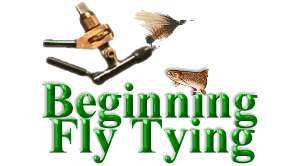Perhaps the most important tool you'll use in fly tying is the fly vise.
If you look in fly fishing magazines, you'll have an opportunity to see
plenty of advertisements for lots of different fly vises. It can get
confusing just trying to sort out the features you need from the ones they
say you need. So, what's the bottom line? What features are important in
a fly vise?
First, a good fly vise must hold a variety of hook sizes and shapes
securely. It isn't enough to hold just a few sizes or shapes well, it must
hold them all. If the vise won't do that, don't buy it. That's the most
basic and important requirement.
The jaws of the vise must be positioned or be able to be positioned at an
angle that allows you to tie flies of various sizes with it. Some vises
have jaws that are too big to use with a variety of hooks. Others don't
have the jaws positioned at an angle that allows the tyer to work with
small hooks.
Look for a vise that has jaws positioned at an angle that allows you to
work around and with the smallest hooks you might someday use. That might
be size 28, so check to see if the vise will hold this size hook securely
while allowing complete access to the main length of the hook shank.
Many vises have heads that pivot or rotate. These are nice features you
should consider when shopping for a fly vise. Although a rotary feature
isn't a necessity, it is a convenient feature you should consider. Many
expert tyers use vises with heads that are fixed and don't pivot or rotate.
You'll have to decide if these are important features you're willing to
invest in. Keep in mind, a lot of extra features won't make a vise hold a
hook any better.
A good vise should be easy to adjust to fit a variety of hooks. Although
many vises will adjust to hold a variety of hook sizes, some are easier to
adjust than others. I use a Regal vise most of the time because it doesn't
require any adjustment for hook sizes or shapes. This isn't just because
I'm lazy, but as a past commercial tyer, I found it much faster to have a
vise with jaws that opened and closed with a squeeze of a lever. Less
adjustment resulted in saved time and time is money to a commercial tyer.
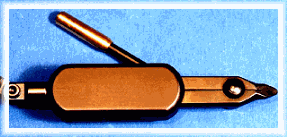
Avoid any vise that takes a lot of time or manipulation to adjust to a
specific hook. One or two twists of a knob should be the maximum
adjustment required to set any vise to a specific hook. After adjustment,
a good vise should clamp down on a hook with a simple twist of a knob,
squeeze of a lever or push of a cam. If it's harder than this, let someone
less informed monkey with the vise while you tie flies on your new, easy
functioning vise.
The size of the head and jaws of a vise will have an impact on how easy it
is to use with certain size hooks. One specific vise on the market has a
fast rotary feature that looks nice, but the jaws of the vise are so big it
isn't feasible to use with small hooks. Small jaws are easier to work
with.
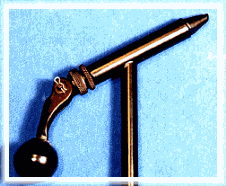
Another thing you need to consider is how the vise is supported. A clamp
is nice if you have a permanent tying bench or you want a vise that just
won't move while you're putting pressure on a hook. A pedestal base is
convenient if you are working on the kitchen table or traveling. It
supports the vise with a heavy base that sets on the table like a lamp
would, and it's easy to move. Most vises can be purchased with either a
pedestal base or a clamp. Some vises come with both support systems. Try
to get a look at both before you buy a vise.
Take a look at the warranty. Some nice vises don't have a warranty. That
doesn't mean they won't work for you, just that you'll have the opportunity
to buy another vise if anything goes wrong with your vise. For my money, I
like a vise with a lifetime warranty. For the record, Griffin vises have a
replacement warranty that can be serviced at the dealer. I don't know of
any other vises with that nice a warranty, but most quality vises have at
least a lifetime warranty against defects. Likewise, most lifetime
warranted vises must be sent to the manufacturer for repair.
So, what vise is the right one? That will be a matter of personal
preference. If budget is a prime consideration, I've found Griffin vises
to be very nice for a modest price. Even the least costly Griffin vises
hold a hook very well. If speed is the prime function, Regal is likely to
be the fastest. If true rotary is a feature you must have, consider
Renzetti, Griffin or Dyna-King. It won't take long to notice the price
difference you'll have to pay for name and function.
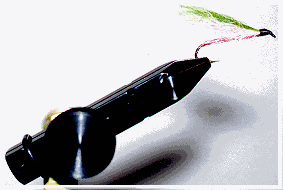
Here's a quick run-down on Griffin vises. I include this because
I believe they have the most vise for the buck available on
today's market. And, they were kind enough to send a couple
of vises for me to photograph for this series. The Griffin
Superior 2A vise is an economical vise (about $40), that held
all the hook sizes I tried in it, and is easy to adjust. It has
a swivel head that adjusts for angle. The Griffin 3AR (not
pictured) is a rotary vise with adjustable head angle and an
arm that allows you to place the vise head away from the stand.
The Griffin Patriot Cam vise has a rotary/swivel head that
locks the hook with a cam. Once the head is adjusted, all it
takes is a twist of the cam lever to change hooks. It also
has a small enough head to work on the smallest of flies.
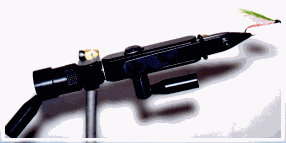 At the top of the list is the Griffin Odyssey vise. This is
a true rotary vise. Unlike similar vises on the market, it
has a feature that allows adjustment of the head to accommodate
different hook sizes and continue to maintain its true rotary
function. It also has a bobbin cradle to hold the bobbin away
from your work at critical steps in the process. All of these
vises can be obtained with a clamp or pedestal base.
At the top of the list is the Griffin Odyssey vise. This is
a true rotary vise. Unlike similar vises on the market, it
has a feature that allows adjustment of the head to accommodate
different hook sizes and continue to maintain its true rotary
function. It also has a bobbin cradle to hold the bobbin away
from your work at critical steps in the process. All of these
vises can be obtained with a clamp or pedestal base.
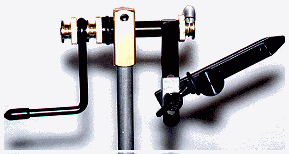
When you go to a fly shop to look for a vise, take a couple of hooks in
several sizes with you. If the hook bends or breaks without slipping in
the vise jaws, it's a good vise for that hook. If it holds all your hooks
that well, has all the features you want, and is easy for you (not just the
salesman) to adjust, buy it. That's the vise you need.
I've never found a motorized vise that was really functional. Nor have I
found a bargain vise that was a bargain. Before you purchase a vise, play
with a couple of them at a fly shop. If you must order a vise through the
mail, insist on a return policy that allows you to return any vise that
won't hold a hook or doesn't perform the way you need it to perform.
Look at a few vises in a fly shop and the magazines. Somewhere out there
is the vise you need. You just have to find it.
We'll look at more tools next week. ~ Al Campbell
Beginning Fly Tying Archives
|
